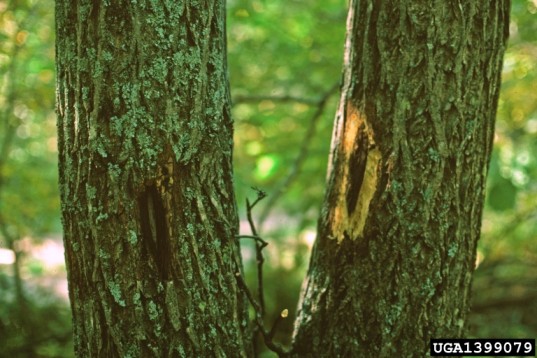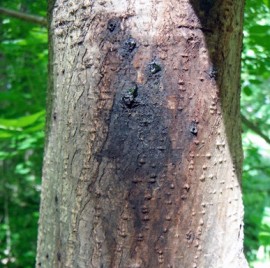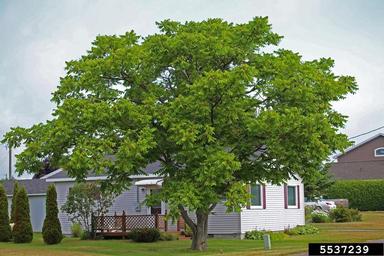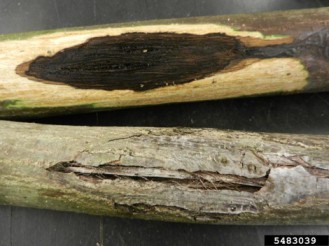Butternut Canker (Ophiognomonia clavigignenti-juglandacearum)
French common name: Chancre du noyer cendré

An infected butternut tree.

Butternut canker on a tree.
Photo: Taylor Scarr, MNRF
Order: Diaporthales
Family: Incertae sedis
Butternut canker disease affects butternut trees and occurs when the S. clavigignenti-juglandacearum fungus enters the tree and causes cankers to form on the trunk, branches, or exposed roots. Canker development on the trunk can girdle the tree, leading to canopy dieback and eventual tree mortality. This disease is present throughout the natural range of the butternut tree in North America, which is especially worrisome as this tree is endangered in eastern Canada. The origin of the fungus is not known, though some scientists trace it back to Asia.
Infection by the S. clavigignenti-juglandacearum fungus causes cankers to form on the bark of the trunk, branches, and exposed roots of vulnerable trees. Cankers first appear as sooty dark patches on the bark and develop into broad, sunken dead areas, dark brown to black in colour. Beneath the bark, S. clavigignenti-juglandacearum produces a thick, black mat of hypha. Eventually, the bark infected by cankers will begin to crack and fall off (University of Vermont, 2002).
A fungal infection by S. clavigignenti-juglandacearum produces thick, black hyphal pegs or stromatal columns underneath the bark of vulnerable host trees. Eventually, these growths will cause the bark to split open and sometimes shed from the tree. Pycnidia (asexual fruiting bodies) develop from the mat of hypha and release spores in creamy masses.
Spores are released throughout the summer by a number of possible vectors; evidence shows that rain, wind, insects, birds, and rodents could all play a role in the spread of spores to new host trees. Fruiting structures have been observed to develop on dead branches in the canopy first, and spores spread to lower areas of the host tree through rain splash and runoff (University of Vermont, 2002).
The main host tree is butternut (Juglans cinerea), although it has the potential to infect other species in the walnut (Juglandaceae) family (NRCan, 2014).

Photo: Rob Routledge, Sault College, Bugwood.org
Signs and symptoms include:
- Dark, sooty patches on bark
- Canopy decline
- Cracks in bark

Photo: David Nisbet, Invasive Species Centre
Some common signs and symptoms of butternut canker disease.
Cankers on the bark are the most obvious symptom of the fungal infection; however, cankers are not unique to S. clavigignenti-juglandacearum. Many species of fungi cause canker disease on a variety of trees, with different levels of severity. In addition, some cankers can even be caused by abiotic influences such as winter frost damage.

Photo: Tom Creswell, Purdue University, Bugwood.org
Signs of butternut canker disease on the surface and below the bark. Beneath the bark, S. clavigignenti-juglandacearum produces a thick, black mat of hypha, which creates broad dead areas of bark.
Butternut canker is distributed throughout the native range of butternut in North America, raising questions about how the fungus spreads. Scientists believe that transportation vectors, likely flying insects, could specifically target butternut trees (University of Vermont, 2002).

Map: U.S. Geological Survey
Native range of the butternut tree.
Further Reading
The Invasive Species Centre aims to connect stakeholders. The following information below link to resources that have been created by external organizations.
